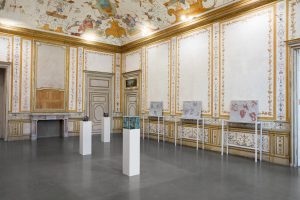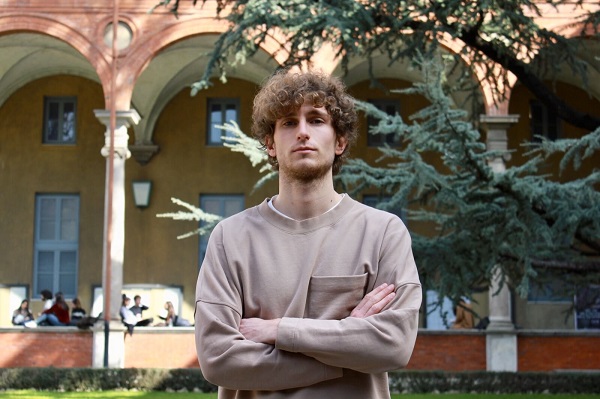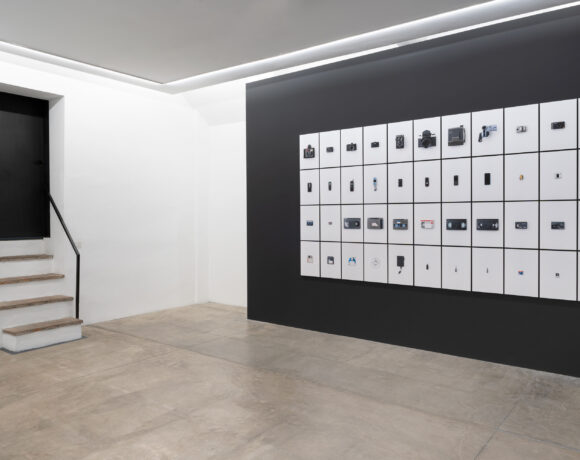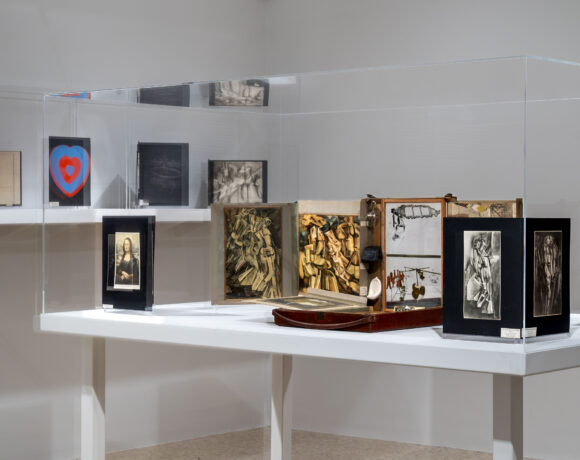The two rooms on the first floor of the Castello di Rivoli act as an inimitable stage for “Agnieszka Kurant. Crowd Crystal “, solo-show by the Polish conceptual artist Agnieszka Kurant (Lódz, 1978). As suggested by the title, the skeleton of the exhibition is built around the concept of “crowd crystal”, introduced by Elias Canetti in “Crowds and power” (1960), within which, in a period of a lifetime (38 years), the author engages in an unconventional and metaphorical analysis of the concepts of crowds and power among the most varied forms and cultures. Hence, among the multiplicity of typologies described, it emerges the “crowd crystal”, identified as that particular category made up of a multitude of individuals each one with its attributed activity. The crowd crystal, therefore, finds its limit in “extension” not so much in spatial terms as in the members that compose it.
Based on a similar theorization Agnieszka Kurant manages to structure a complex and ramified narrative aimed, in general, to shed light on the constant interaction and interpenetration of the micro and macro levels not limiting her research on the basis of stale categorizations but making her works stand out as the result of the mixture of the multiple spheres constituting creation, from the human, animal, bacteriological kingdom to the digital. And it is precisely this unstoppable complexity of interactions between different levels that represents a key point of her stylistic code and for which the presented works stand as a glaring exemplification. In this regard, one of the first works encountered is “Chemical Garden”, a concentrate of sodium, silicate, copper, nickel, cobalt, chromium, manganese, iron and zinc salts, able to demonstrate that the interpenetration and continuous exchange of inorganic elements can give life to vital and organic material with plant appearance.
What Kurant cleverly manages to highlight through this colourful range of ramifications is precisely a questioning of the neo-liberal interpretation of the concept of growth based on the linear, continuous and frenetic process of human resources exploitation, highlighting how much such construction is inappropriate in representing those evolutionary dynamics that are instead captured by the artist on the basis of completely multidirectional growth systems. Therefore, Kurant seems to emphasize the existence and implementation of models of coexistence between different spheres of creation, slowed down and less totalizing than the dominant paradigm.
Another central theme in the conceptual practice of the Polish artist can be found, in addition to the idea of system, in the propensity of the human community to leave its own trace. Something that emerges in a different way and with different strengths in the other works on display, such as the two sculptures from the series “Post-Fordite”. These were made by accumulating that type of automotive paint known as Fordite taken from a multitude of abandoned factories and appearing to the observer as a materialization of the footprints left over time by the indistinct mass of workers. Then, there is the series of sculptures “Adjacent Possible” placed against the walls, able of emanating, both for aesthetic connotations and underlying theoretical research, an aura with a primordial flavour, as well as to establish a dialogue – at times both of fluid homogeneity and violent interruption – with the delicate motifs decorating the surrounding space. The Luserna stone sculptures were developed on the basis of a reflection conducted on the discovery of 32 signs dating back to the Paleolithic by the paleoanthropologist Genevieve von Petzinger. Therefore, collaborating with the computational social scientists LeRon Shults and Justin Lane she applied a neural artificial intelligence network to a photographic archive containing a multitude of combinations of the aforementioned symbols to generate a real alternative set of signs. These have been reported on stone using colour pigments containing mutated bacteria with genes of corals, jellyfish, moulds and so on. So almost animated pigments, able to determine the outcome of the final sign form through technological partnership.
Leaving aside, as far as possible, the complexity of the creative process as well as the ability to reconcile and extend her artistic practice with a wide variety of skills only apparently distant, one cannot help but remain hypnotized in front of the works. What is elaborated and proposed is in fact an authentic questioning of what the alternative development paths of human civilization could have been if, as a starting point, there had been a different system of symbols and communication. Again, a reflection on the potential of non-linear and alternative developments as well as on the traces left by the community within a system, all compressed into overwhelmingly powerful works. Finally, on this same line, there are “Conversions”, liquid crystal paintings created using data mining technologies with which Kurant has ventured into a process of collecting the most heterogeneous feelings – such as joy, anger, pain – expressed on social media by the masses of protesters. With the change of their digitally mediated emotions, there is therefore the consequent physical change of the works in a metaphor exemplifying how each action corresponds to a concrete alteration in the real world. “Conversions” is also part of that corpus of works with which Kurant does not simply point the finger at the limits of the current neo-liberal paradigm but instead tries to offer potential alternatives not only on an ideological but also a pragmatic level. The profits deriving from the sale of the works are in fact redistributed in that same “exploited” network by the artist in a clear reversal of today’s capitalist dynamics of extrapolation and online data sale.
Agnieszka Kurant’s practice is therefore of a conceptual and manual complexity that is difficult to ascribe within rigid categorizations. What it exhibits, on the other hand, is a more absolute ease in creating dialogues and narrations by drawing on the multiple spheres of expression of the human intellect, helping us to understand how the existence is made up of a more absolute stratification, ramification and contingency. Something that, she warns us, cannot and must not be trivialized as a simple straight line.
Gabriele Medaglini
Info:
Agnieszka Kurant. Crowd Crystal
4/11/2021 – 27/02/2022
Castello di Rivoli Museo d’Arte Contemporanea
Piazzale Mafalda di Savoia, 10098 Rivoli TO
 Agnieszka Kurant. Crowd Crystal. Installation view of the exhibition at Castello di Rivoli Museo d’Arte Contemporanea, Rivoli-Torino (November 4, 2021 – February 27, 2022). Photo © Sebastiano Pellion di Persano. Courtesy Castello di Rivoli Museo d’Arte Contemporanea, Rivoli-Torino
Agnieszka Kurant. Crowd Crystal. Installation view of the exhibition at Castello di Rivoli Museo d’Arte Contemporanea, Rivoli-Torino (November 4, 2021 – February 27, 2022). Photo © Sebastiano Pellion di Persano. Courtesy Castello di Rivoli Museo d’Arte Contemporanea, Rivoli-Torino
 Agnieszka Kurant, Adjacent Possible (Possibile adiacente), 2021. Genetically engineered bacteria, fungi, lichens, 20.000-years-old ochre paint on Luserna rocks. 70 x 100 cm each rock. Courtesy the artist and Tanya Bonakdar Gallery, New York/Los Angeles
Agnieszka Kurant, Adjacent Possible (Possibile adiacente), 2021. Genetically engineered bacteria, fungi, lichens, 20.000-years-old ochre paint on Luserna rocks. 70 x 100 cm each rock. Courtesy the artist and Tanya Bonakdar Gallery, New York/Los Angeles
 Agnieszka Kurant, Chemical Garden (Giardino Chimico), 2021. Sodium silicate, copper, nickel, cobalt, chromium, manganese, iron, zinc salts; collaboration: dr Magdalena Osial, Warsaw University. Courtesy the artist and Tanya Bonakdar Gallery, New York/Los Angeles
Agnieszka Kurant, Chemical Garden (Giardino Chimico), 2021. Sodium silicate, copper, nickel, cobalt, chromium, manganese, iron, zinc salts; collaboration: dr Magdalena Osial, Warsaw University. Courtesy the artist and Tanya Bonakdar Gallery, New York/Los Angeles
 Agnieszka Kurant, Post-Fordite 2, Post-Fordite 5, 2019-2020. Fossilized automotive paint, resin, foam, powdered stone, steel. Courtesy the artist and Tanya Bonakdar Gallery, New York/Los Angeles
Agnieszka Kurant, Post-Fordite 2, Post-Fordite 5, 2019-2020. Fossilized automotive paint, resin, foam, powdered stone, steel. Courtesy the artist and Tanya Bonakdar Gallery, New York/Los Angeles

With a specialist degree in Economics and Management of Cultural Heritage, passionate about the field of Contemporary art, its economic dimension and, more generally, the dynamics characterizing the art market, Gabriele has gained experience over time in contexts such as contemporary art galleries, start-ups and Art Advisory. He currently works in the Art-Rite auction house as an assistant in the department of Modern and Contemporary art.






NO COMMENT